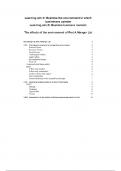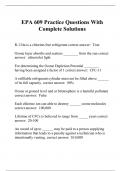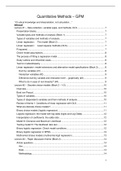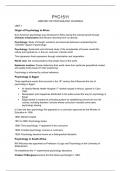Physical evidence
Generally refers to objects that come from nonliving subjects that can prove a crime has
been committed. And can also link crimes to victims and suspects. Most commonly found
are fingerprints, footprints, handprints and tire marks.
Biological evidence
Materials or substances that contain biological material - provide a source of DNA which can
be used to link people to crime scenes and identify suspects and victims. Some examples
include blood, skin cells and tissue, saliva and bones.
Chemical evidence
Includes any chemical found on people, objects or in solutions that are collected from the
crime scene or related locations - may have been used to assist with the crime. Chemical
evidence can be drugs, poison and inks/dyes/paints.
Type of evidence can be split into two areas: physical and testimonial. Physical evidence can
be used to prove or disprove facts about the investigation, and involve material substances
such as blood and chemicals. Testimonial evidence is any witness accounts of the crime or
incident. Evidence collected at a crime scene can prove that a crime has been committed,
link a suspect or victim with a crime, establish the identity of a suspect or victim, support
verbal witness testimony, and exonerate the innocent.
Health and safety
There are many rules that must be followed by employees and workers to ensure the safety
of everyone involved in investigating crime scenes due to the many hazards that may be
present at them; some examples of these acts include the Health and Safety at Work Act of
1974, Control of Substances Hazardous to Health (2002), and the Dangerous Substances
and Explosive Atmospheres Regulations (2002). These acts and regulations ensure that
employers are taking care of their workers by having risk assessments written and
establishing all known hazards, as well as providing the correct PPE to protect all
investigators and attenders of the crime scene. Risk assessments may include identifying
whether the structure of the building is safe, whether windows have been shattered or
whether bodies are present at crime scenes as they may contain pathogens such as
hepatitis or HIV. As well as identifying hazards, risk assessments should also include
measures that have been put into place in order to prevent harm to any attending officers or
investigators, and the steps that should be taken in the case of an emergency due to any of
these hazards. Some examples of SOCO PPE include hairnets, overshoes, protective
goggles, masks and coveralls. SOCO must wear PPE when examining or visiting crime
scenes not only for physical protection against hazards such as blood or faeces, but also to
prevent them from contaminating any potential forensic evidence, and to also prevent them
from incriminating themselves. (SANTA BARBARA SHERIFF’S OFFICE FORENSICS UNIT
CRIME SCENE SAFETY MANUAL, n.d.)
Assessing the crime scene
The FOA (First Officer Attending) must carry out an immediate assessment of the crime
scene and deal with any present emergencies, such as injured individuals, and detaining any
witnesses and suspects in case an investigation needs to be conducted. In order of what to
do, the FOA must:
1. Assess the scene
, 2. Judge whether further assistance is required and act on these judgements
3. Search for and arrest any suspects
4. Determine if there are any injuries or witnesses
5. Preserve any potential evidence from beyond destroyed by weather such as setting
up a cover to protect evidence from rain
A corden with crime scene tape should be set up by an officer in order to protect the crime
scene and contain the evidence within it from the general public - with people guarding and
professionals attending the crime scene, this is an added security measure against people
invading the scene to tamper with evidence. Protective clothing must be worn by all who visit
the crime scene in order to prevent the destruction of any potential forensic evidence - if
evidence is broken or contaminated then it can quickly skew the outcome of an investigation
and may result in victims not being given justice and perpetrators not being charged or
sentenced.
Before searching the crime scene and collecting and recording evidence, the crime scene
must be fully documented in order to have a permanent record of it. This can include
pictures, videos, sketches and written notes. After this documentation, investigators can then
begin to mark and collect evidence. It’s important to prioritise the collection and preservation
of evidence that may be fragile or have a time limit on it, or that may be vital to the
investigation. Any bodies at crime scenes can often not be touched or moved until the
necessary specialist arrives, such as a pathologist. When evidence has been marked, it is
photographed from every angle and a description is written of it; rulers are often placed next
to evidence as well to demonstrate its size in photographs. It is important to capture the
evidence from every angle before collecting it in case the quality of it degrades or it becomes
damaged - the documentation of how it appeared untouched at the crime scene must be
kept. Evidence should then be collected correctly and stored in the packaging that maintains
it the best. The order of crime scene protocol is: interview, examine, photograph, sketch,
process.
Search patterns
The type of search pattern used for an investigation depends on several factors including,
the type and nature of the crime, and the size, location and complexity of the crime scene.
Search method What is it? Where are they most
useful?
Walkthrough Brief walk over the crime For any crime scene of any
scene to mentally outline size with any amount of
how the crime scene will be obstructions
examined and to note down
where potential evidence
may be.
Grid search Lines are imagined across Useful for large indoor and
the crime scene in a grid outdoor crime scenes
pattern, and investigators
search the location following
the lines
Line/lane search A line is imagined Well suited for crime scenes










